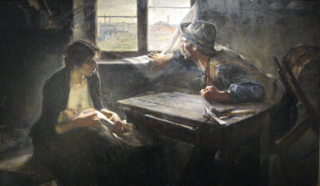TRENZAS (“Braids”): Full text plus subtitled video in Spanish and English
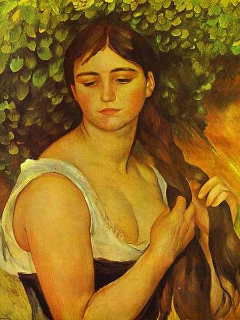 TRENZAS (Braids)
TRENZAS (Braids)
Tango, 1944
Lyrics by Homero Expósito
Music by Armando Pontier
Recorded by Orquesta Típica Miguel Caló with vocal by Raúl Iriarte, 1945-02-20.
Subtitled tango video in Spanish and English, followed by full text, including unsung third stanza.
|
Trenzas, ¿Adónde fue tu amor de flor silvestre? [Pena,
|
Braids, soft silk of your braids, moon in the shadow of your skin, and of your absence. Braids that bound me in the yoke of your love almost tender yoke of your laughter and your voice. Exquisite charity of my daily routine, I found your heart on a street corner…. Braids the color of bitter maté that sweetened my dull lethargy. Where did it go, your wildflower love? [Sorrow, |
Subtitled Tango No. 33: SE VA LA VIDA (Edgardo Donato, 1936)
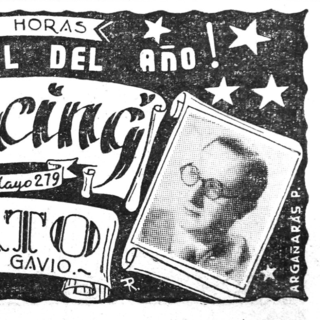 SE VA LA VIDA (Life Goes…)
SE VA LA VIDA (Life Goes…)
Tango, 1936
Music: Edgardo Donato
Words: María Luisa Carnelli (a.k.a. Luis Mario)
Subtitled video in Spanish and English: Michael Krugman
Note: Edgardo Donato’s familiar, super-danceable performance of Se Va La Vida, below, includes only partial lyrics. Azucena Maizani’s very fine tango canción version includes full lyrics. Please hear our subtitled video of that, too!
Woman to woman: An intimate interview with Tania
 "She Turned Down 300 Dollars A Day By Returning to Buenos Aires…"
"She Turned Down 300 Dollars A Day By Returning to Buenos Aires…"
Any Tania fans out there? I certainly am one.
For those who may not know, Tania (13 October 1893-17 February 1994!) was a Spanish singer and actress best known for her artistic and personal association with actor, director, poet, playwright, and tango lyricist Enrique Santos Discépolo. (They met after the poet heard her sing his super-edgy tango ESTA NOCHE ME EMBORRACHO in Buenos Aires's "Folies Bergère" cabaret, and was delighted with it, and her.) But Tania was a star in her own right, and she had her own unique personality and aura which is charmingly revealed in this very intimate, woman-to-woman interview that she gave to tango bandleader Ebe Bedrune for the weekly magazine "Cantando" in 1945. We hope you'll enjoy it!
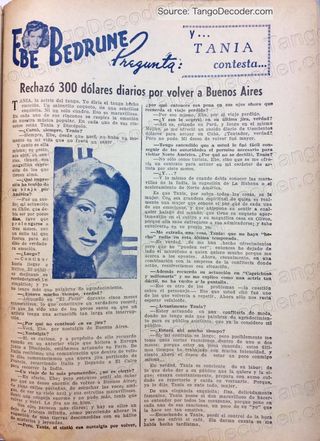 (A very nice bio of Tania at TodoTango.com calls her un cascabel radiante, "a radiant jingle bell." Worth a read.)
(A very nice bio of Tania at TodoTango.com calls her un cascabel radiante, "a radiant jingle bell." Worth a read.)
Click on the image to see a fully legible, hi-res version of the original article. (Photo source: Tango Time Machine.) Or read our English-language transcript below.
***
Ebe Bedrune Asks, and Tania Answers…
She Turned Down 300 Dollars a Day By Returning To Buenos Aires
Tania, "the actress of tango." I would say, tango made emotion. A coquettish little room, of exquisite simplicity. Not even a painting on the wall. This is marvelous. Each and every corner breathes the soul of our popular music. In each and every corner is Tania and Discépolo.
Ebe: Did you always sing, Tania?
Tania: Always, Ebe, from the day I was born, there was not a moment in my life in which I wasn't a singer.
And she herself is song, her gestures, her eyes, her smile, have that magnificent expression of those who have soul.
What impression did you have on your tour of America?
It was a dream; my performance in Chile, that was supposed to be only a few days, had to be extended for three months, with such success that they were truly emotional days.
And then?
I went on to Mexico. The Mexican public is really sympathetic; and the only word I can say is "thanks."
You were there quite a while, weren't you?
Performing in El Patio for five consecutive months, which set a real record; one of the few cases in which an artist has had such a long appearance without a break.
And why didn't you continue your tour?
You see, Ebe: Out of homesickness for Buenos Aires.
Homesickness?
Yes, it's odd, it reminds me of an earlier visit to Europe when Discépolo and I were performing in Paris. From Italy we received a message saying that in twenty days we were to start a new tour leaving France, returning to Italy, and arriving at Cairo to go across India.
A most promising trip, was it not?
Really, Ebe; but then I felt, without knowing why, an enormous desire to return to Buenos Aires; to walk the port-city streets, to hear the friendly voices, to see its blue sky and its marvelous stars. I was seized by an enormous heartbreak; I had to return, and I did. I didn't do the tour.
Her eyes seem clearer; and there is in them a trace of infinite sadness; they seem to be longing for the suggestion of those strange lands with their breath of mystery and legend.
But, Tania, if you felt such homesickness that you had to return, why this sorrow in your eyes now that you remember the lost trip?
For just that, Ebe, for the lost trip.
And it happened to you again this time, right?
That's right. After being in Peru, and then in Mexico again, they offered me a salary of thre hundred dollars a day to perform in Cuba. [Almost $4000 in today's currency, according to dollartimes.com.–TD] Tempting, right? But I couldn't do it. My desire to return was stronger.
I've heard that it was easy for you to convince the authorities to give you the visa necessary to visit North America. Why didn't you choose to go, Tania?
Not only as a tourist, Ebe, but they offered me a contract to perform in my capacity as an artist for six months.
And…?
And the same as when I was supposed to see the wonders of India, the Havana offer, and the North American visa.
It's that Tania, above all, is a woman. The spiritual grandeur of one who is truly a woman who knows the why of each one of her emotions, and puts them first before whatever flattery the world may bestow; who has her coquettish little apartment in El Centro and her grand home in Olivos, because she knows when to devote herself to her fans; and she knows when to wrap herself up in herself.
One thing surprises me, Tania: that you haven't "done" radio this last season.
It's true. They made me some offers but they "could not be"; so I have put aside the microphone that I love so much because it brings me closer to the listeners. Now, casually, in conjunction with of the confitería where I sing, we're going to solve that problem.
I still remember your performance in "Caprichosa y millonaria" [Capricious Millionaire, a 1940 film directed by Discépolo, with Tania in a starring role.—TD] and I can't understand how such a gifted actress has not returned to the screen.
That's another problem—the question of character (personaje). The one you cited was one I wouldn't mind doing again. Now I can only hope for a film role.
Currently, Tania?
I am performing in a stylish confitería [probably the cafetería "Luba," at Suipacha 580–TD] where I have nothing but praise for the the audiences, whom I now consider to be my fans.
Will you be there for a long time?
Yes, my contract is long; but possibly I'll take some short vacations for a month or two; because I'm a little tired; for some time I've been working very intensively, and I feel the desire now to be all by myself a little.
In truth, Tania is very conscientious about her work; about that which she has to give the fans who love her and follow her; she rehearses constantly, she prepares her repertoire with supreme care, and she attends to her costumes, because, as I said before, Tania is, before anything else, a woman.
Of an exquisite elegance; fine, delicately feminine. Tania possesses the marvelous gift of making herself understood to every heart, because she puts a little of her "self" into every one of her songs, which is what makes them so moving.
Listening to Tania, I lost track of the time and my coffee went cold. Without my noticing, it had gotten very late.
Subtitled Tango #30: PERO YO SÉ (D’Agostino/Vargas 1942)
"I know that in the wee hours, when you leave those wild parties, you feel your heart burdened by a fond memory, and you start to cry…."
PERO…YO SÉ (But…I know)
Tango, 1942
Words and music by Azucena Maizani
Our subtitled video follows. Scroll down for side-by side Spanish and English lyrics. A complete playlist of all our subtitled tangos is here.
| Llegando la noche recién te levantas y sales ufano a buscar un beguén.*
Lucís con orgullo Paseás por Corrientes,
De regios programas
Pero yo sé que metido
Yo sé que en las madrugadas,
Con tanta aventura,
Con todo el dinero Pensar que ese brillo
Tu orgullo de necio |
Night is falling You show off with pride You drive along Corrientes, You’ve got piles of But I know that inside I know that in the wee hours, With so many affairs, With all the money To think that this brilliance Your foolish pride |
Azucena Maizani (1928)
Julio De Caro’s Carnaval Gig, 1941
Carnavál 1941. 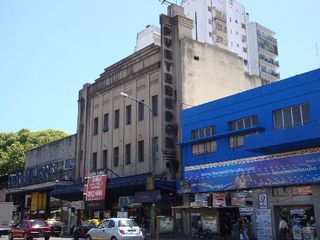 Julio De Caro plays 7 shows at the Teatro Pueyrredon de Flores opposite Eddie Kay and his Alabama Jazz. Segments of the shows were broadcast live on Radio El Mundo.
Julio De Caro plays 7 shows at the Teatro Pueyrredon de Flores opposite Eddie Kay and his Alabama Jazz. Segments of the shows were broadcast live on Radio El Mundo.

The building (top, right, from parabuenosaires.com) was created by Belgian architect Alberto Edmundo Bourdon (1881-1965). It still stands, but is currently slated for demolition.
The ad from El Mundo newspaper is below, right. The text is:
"…and remember that the traditional dances of the PUEYRREDON de FLORES, Rivadavia 6871, are starting tomorrow. Típica Julio de Caro – Eddie Kay and his Alabama Jazz."
“At the Foot of the Holy Cross”: A Tango Protest Song
The 1933 tango Al pie de la santa cruz ("At the foot of the holy cross") tells the poignant story of a striking worker who is punished by being transported, probably to the notorious Ushuaia prison in Tierra del Fuego, leaving his wife, child, and aging parents weeping at dockside. It is one of the few explicitly political protest-songs among tango lyrics.
Lyrics in Spanish and English, notes, recording history, and further commentary are below the text.
AL PIE DE LA SANTA CRUZ
"At the foot of the holy cross"
1933
Music by Enrique Delfino
Lyrics by Mario Battistella
|
Declaran la huelga,
Mientras tanto,
Los pies engrillados,
|
A strike is called, Meanwhile, With shackled feet |
NOTES
* The Boss's Law: As far as I can tell, La Ley Patronal is not the name of a specific law, but a poetic and derisive characterization of the law in general, implying that it serves the patrones (bosses) rather than the working people.
* Holy Cross: The image of the worker's mother praying at the foot of the "holy cross" is a touching one; it links the suffering of the worker and his family to the suffering of Jesus Christ. The words may have a double meaning, however: according to some sources (one is cited below), the ship that transported prisoners to the Presidio de Ushuaia in Tierra del Fuego was called Santa Cruz. Hence many bereft families actually stood on the pier, literally "at the foot of the Santa Cruz," when they saw their loved ones carried away by that "cursed ship."
Further commentary from Gardel.es (translated by TD):
"Al pie de la santa cruz was born as a reflection of the socio-economic deterioration suffered by Argentina after the economic crash of 1930. It denounces the brutal repression by the de facto government of General Uriburu, which ordered the suppression of protests by means of shootings, mass imprisonment, and deportations.
"The lyric is explicit yet leaves room for poetic allegory, suggesting by its title the suffering of Jesus Christ. Santa Cruz was in its day the name of a navy prison-ship at the foot of which, from the pier, the teary-eyed family would see the loved one leave on his calvary.
"Transports," they were called. In the National Penitentiary it was known that the most feared punishment was being transported to "The Land" [Tierra del Fuego—TD]. After a medical checkup and a meal, the prisoners were told they would be transported to Ushuaia. In the morning they had to put all their things together, submit to an inspection, and then be shackled with iron bars that didn't permit them to advance more than fifteen centimeters. In short order, the condemned not only had the skin peeled from their ankles, but from their souls, too. (Guillermo Saccomanno, 2008)
RECORDING HISTORY
The song was recorded by Carlos Gardel in 1933 and by the Orquesta Típica Victor with vocal by Alberto Gómez in the same year. A heavily rewritten, apolitical version of the lyric was recorded by Alfredo De Angelis in December 1949, during the reign of Juan Perón but almost a year after the formal lifting of the censorship of tango lyrics. Asked about the bowdlerized recording years later, De Angelis answered, "What do you want? By other means, they held me prisoner, too." It would seem that this lyric, with its social-realist imagery, its sharp political commentary, and its compelling appeal to humanistic values, was still too incendiary for the time.
THE LYRICIST
Lyricist, translator, dramatist, and talent agent Mario Battistella (1893-1968) was born in Verona, Italy and spent much of his life in Argentina. He was the author of Cuartito Azul, Melodía de arrabal, Bronca, Remembranza, and approximately two hundred other lyrics, many of which were written for the stage and were heard only during the run of the shows for which they were written. He was a collaborator and advisor to Carlos Gardel, the manager of Argentino Ledesma and Edmundo Rivera, and the director of several Buenos Aires theaters.
“Julio De Caro Composed His First Tango in 1915”
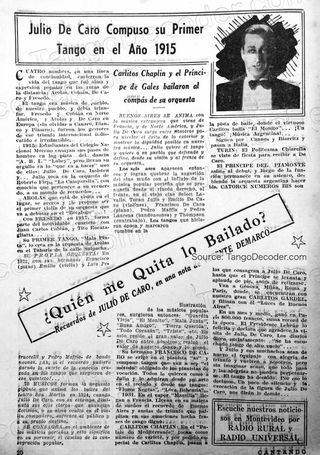 From "Cantando" weekly, 1945. Translation by Tango Decoder. Photo from the Tango Time Machine archives. At the bottom of the page, the De Caro orchestra is seen in a clip from "Luces De Buenos Aires."
From "Cantando" weekly, 1945. Translation by Tango Decoder. Photo from the Tango Time Machine archives. At the bottom of the page, the De Caro orchestra is seen in a clip from "Luces De Buenos Aires."
By Vicente Demarco
Four men in a continuous line set the life of the tango, its soul and its popular expression, on its far-flung travels: Arolas, Cobián, De Caro, and Fresedo.
Tango was the music of the people, of our people, and it had to triumph. Fresedo and Cobián in North America, and Arolas and De Caro in Europe (without forgetting Canaro, Bianco and Pizarro), were the agents of this indisputable and irrepressible international triumph.
1915: Students of the Colegio Nacional Moreno rehearse their manly steps on the pista of the dance hall "A. B. I." "Labey", but they take pride in "what is going to happen" to one of them: Julio De Caro. They insist and… Julio plays "La Cumparsita" in the orchestra of Roberto Firpo, with emotion that belongs to his memory, to his world of memories.
AROLAS, who is a visitor to the place, approaches and asks him to be the first violin of his orchestra that's going to debut at the "Botafogo"…!
With FRESEDO in 1917, he forms part of the unforgettable quartet with Juan Carlos Cobián and Tito Rocatagliatta…
HIS OWN ORCHESTRA: In 1922, with his brothers Francisco (piano) Emilio (violin) and Luis Petrucelli and Pedro Maffia on bandoneones. Ah! If only memory could give us the chance to feel the emotion locked in the tangos produced by that quintet!
70 MUSICIANS formed the giant orchestra that enlivened the dances of the Teatro San Martín in 1924, when Julio De Caro, with his diminutive form and his clear eyes that communicated decisiveness, and his soul hidden in the accompanying violin, faces the public and his own fate.
He is recognized by the Buenos Aires music scene, and this signifies his future and his popular recognition.
Buenos Aires is excited by the foreign music that comes from France, and from North America, and Julio De Caro appears to counterbalance the success of the foreign and to demonstrate the dignity possible in our music… Julio loves tango and loves his people, who he defines and defends with his violin, in front of his orchestra.
The six aces appear then and they succeed in moving Buenos Aires' popular music from the right-hand corner of the silent-movie theater to center stage at the old Select Lavalle cinema. The players are Julio and Emilio De Caro (violins), Francisco De Caro (piano), Pedro Maffia and Pedro Laurenz (bandoneones) and [Leopoldo] Thompson (contrabass). The tangos that mark this epoch and set the example for other musicians are "Guardia Vieja," "Mala Junta," "Buen Amigo," "Tierra Querida," "Todo Corazón," "Triste," etc. In this resides the great value of Julio De Caro for us: he extolled the value of our tango, and he elevated it.
His brother Francisco De Caro was declared an "ace" of the tango and he composed tangos that would be "the method" required by aspiring pianists. Everyone loved him as they did Julio, and admired him for his keyboard artistry and for his tangos: "Flores Negras," "Loca Bohemia"….
1931. On the steamship Massilia they arrive in France. They carry in their suitcase of dreams the memory of Buenos Aires and an eagerness for triumph that throbs in their hearts and is expressed in dignified tango phrases.
CHARLIE CHAPLIN: In the Palais [de la] Meditarranée [Nice, France] they play as a variety act [i.e., in concert] and by special request of Charlie Chaplin, they move to the dance floor where the virtuoso Charlie dances "El Monito"… A tango! Argentine music! They continue via Cannes and Biarritz, to Italy.
TURIN: The (Theatre) Politeama Chiarella holds a gala reception for De Caro. The Prince of Piamonte attends the debut, and after the performance he stays in his seat, compelling the Argentina orchestra to play fourteen encores, after which the prince gives a standing ovation before leaving. They go to Genoa, Milan, Rome, and Paris where they meet our great CARLOS GARDEL, and film with him "Luces de Buenos Aires."
In a month and a half in Paris they earned 800,000 francs, a record for the period. President Lebrún congratulates them and thanks them or coming. The dailies say succinctly: "One has heard tango of a very high level."
And Julio and the guys pack their bags again with the joy of triumph and return to us, without imagining perhaps, that everything passes and the happiness can't last. The tango has declined. Therefore we say: A moment of silence in memory of the figure of Julio De Caro… enough said.
Firpo Talks! (“Cantando,” 1945)
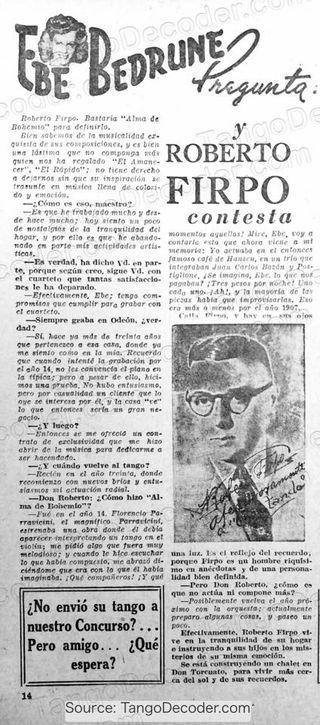 Bandleader Ebe Bedrune, "The Lady in White," interviewed Maestro Roberto Firpo for the weekly magazine "Cantando" in 1945. Translation by Michael Krugman for Tango Decoder. Photo source: Tango Time Machine Archives.
Bandleader Ebe Bedrune, "The Lady in White," interviewed Maestro Roberto Firpo for the weekly magazine "Cantando" in 1945. Translation by Michael Krugman for Tango Decoder. Photo source: Tango Time Machine Archives.
Roberto Firpo. "Alma de Bohemio" would be enough to define him. We know well the exquisite musicality of his compositions and it's really a shame that he who composed "El Amanecer" and "El Rápido," didn't compose more; he has no right to leave us without his inspiration which produces music so full of color and emotion.
Ebe Bedrune: Why is that, maestro?
Roberto Firpo: It's because I've worked a lot and now I'm feeling a bit of nostalgia for the peace and quiet of home, and that's why I've abandoned in part my artistic activities.
Ebe: It's true, you have said in part, because I believe you continue with the quartet that has given you such satisfaction.
Firpo: As a matter of fact, Ebe, I've signed contracts to record with the quartet.
Ebe: You always record with Odeon, right?
Firpo: Yes, it's been more than thirty years that I've been with the label, where I feel very much at home. I remember that when I tried recording in the year '14, the piano wasn't accepted as part of the típica; but even so we gave it a go. There wasn't much enthusiasm, but by chance a client heard it and took an interest, and the label saw that it was marketable.
Ebe: And then?
Firpo: Then they offered me an exclusive recording contract that let me devote myself to ranching.
Ebe: When did you return to tango?
Firpo: In the year '30, when I resumed my radio appearances with renewed energy and enthusiasm.
Ebe: Don Roberto, how did the song "Alma de Bohemio" come to be?
Firpo: It was back in '14. Florencio Parravicini, the magnificent Parravicini (Argentine film actor, 1876-1941) was playing a role in which he was to appear playing the violin. He asked me for something very melodic, and when he heard what I'd composed, he threw his arms around me and said it was everything he had imagined. What pals we were! And what times those were! Listen, Ebe, let me tell you a story that I'm just now remembering: I was playing back then at the famous Cafe Hansen with a trio that included Juan Carlos Bazán and (violinist Francisco) Postiglione. Can you image what they were paying us? Three pesos a night, one peso for each of us! Ay! And the majority of the songs had to be improvised! That was in the year 1907, more or less.
Ebe: But, Don Roberto, why don't you perform or compose more frequently?
Firpo: I might return with the orchestra next year. I'm actually preparing a few things and I'm going out a bit.
Indeed, Roberto Firpo lives in the tranquility of his home, instructing his children in the mysteries of that same emotion. He is constructing a chalet in Don Torcuato in order to live closer to the sun and to his memories.
A Pitiless Riposte: D’Agostino’s “Todo Terminó”
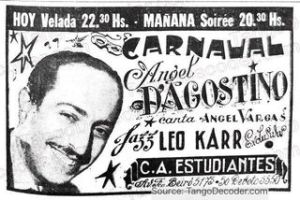 "I alone know what I suffered by forgetting you, by tearing you out of my heart. And now that I’m wise to your tricks, I want nothing to do with you!"
"I alone know what I suffered by forgetting you, by tearing you out of my heart. And now that I’m wise to your tricks, I want nothing to do with you!"
I love this little-heard D'Agostino song that was recommended to us by Mariola Golińczak, so I decided to decode the lyrics by Mario Soto. Nothing mysterious, really, just a straight translation. What impresses me is the forthrightness of the narrator. Borges once said that tango lyrics are "the effeminate whinging of jilted pimps," and with a lot of songs that's just how it seems. Here, the narrator's pitiless riposte has a more forceful, direct quality that demands respect. Take that, Borges!
TodoTango identifies Mario Soto (20 August 1912 – 20 April 1995) as a lyricist, commentator, actor and scriptwriter. He seems to have struggled as an actor and scriptwriter, but he distinguished himself as a lyricist with the milonga COMPADREANDO and the tangos EL YACARÉ, ME LLAMAN TANGO, and the present example, TODO TERMINÓ.
Soto had two other roles that pique my curiosity. One was as the business manager and announcer for the orchestra of Angel D'Agostino: imagine all the curious minutiae of tango lore that must have been stored in his brain! The other is as the glosa artist for D'Agostino, Alfredo Attadia (during Angel Vargas's brief solo bid in 1943), Pedro Laurenz, Osvaldo Pugliese, and possibly others. The glosa artist was a guy who would introduce the songs during live or radio appearances, often reciting a brief poetic verse of his own composition intended to complement the lyrics of the song. The glosa is to my mind part of the hidden history of tango. It was quite common during the Golden Age—and anyone who lived through the era would have been familiar with the custom—though only a few of the verses survive on recording.
The jazzy ad shown above was prepared by the Santa Cruz publicity agency for the D'Agostino orchestra's appearances at Club Atlético Estudiantes during Carnavál. It appeared in the "El Mundo" newspaper's Dance Guide on Saturday, 13 March 1943, and several other times during that year's celebrations.
TODO TERMINÓ (It's all over now)
Tango, 1942
Music: Alfredo Attadia and Ismael Spitalnik
Lyrics: Mario Soto
English-language version by Michael Krugman for Tango Decoder
|
Hoy que la vida te venció, En el perdón que has implorado Antes hubiera perdonado ¡todo!… ¡todo! Ya ni tu llanto me conmueve, |
Now that life has defeated you, you have come back to see if you can take refuge in my love. The only thing that could have brought you to my corner is your humiliation by the man who made you grovel at his feet. The pardon you’ve begged for Back then I might have forgiven everything!… Not even your tears move me to pity, |

